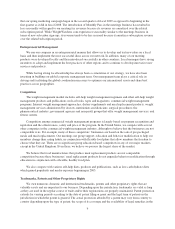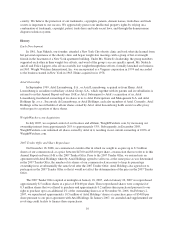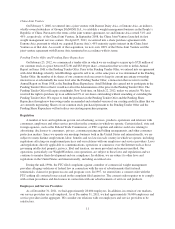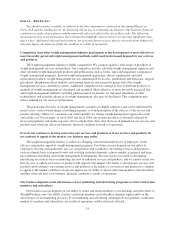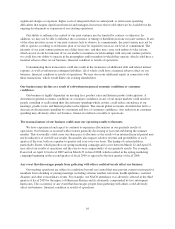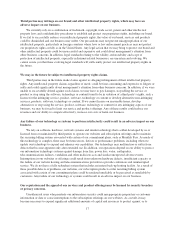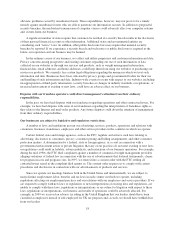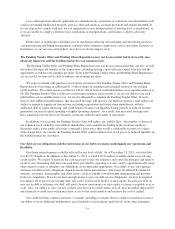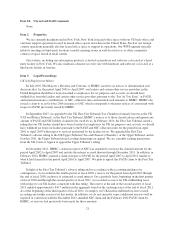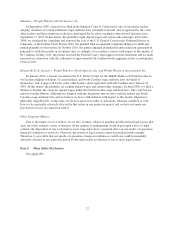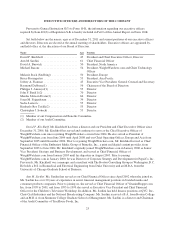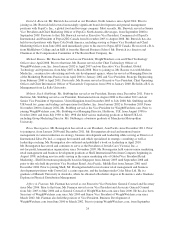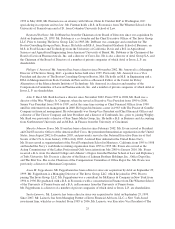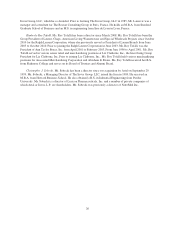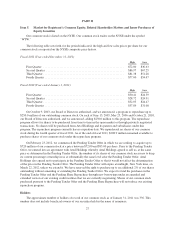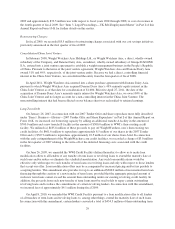WeightWatchers 2011 Annual Report Download - page 37
Download and view the complete annual report
Please find page 37 of the 2011 WeightWatchers annual report below. You can navigate through the pages in the report by either clicking on the pages listed below, or by using the keyword search tool below to find specific information within the annual report.Laws and regulations directly applicable to communications, operations or commerce over the Internet such
as those governing intellectual property, privacy, libel and taxation, are more prevalent and remain unsettled. If
we are required to comply with new laws or regulations or new interpretations of existing laws or regulations, or
if we are unable to comply with these laws, regulations or interpretations, our business could be adversely
affected.
Future laws or regulations, including laws or regulations affecting our marketing and advertising practices,
consumer pricing and billing arrangements, relations with consumers, employees, service providers, licensees or
franchisees, or our services and products, may have an adverse impact on us.
The Pending Tender Offer and Pending Share Repurchase may not be successful and if successful, may
adversely impact us and the trading market for our common stock.
The Pending Tender Offer and Pending Share Repurchase may not be successful and if they are not, we will
not realize the expected benefits of the transactions, including having a more efficient capital structure and the
opportunity to enhance our earnings per share. Even if the Pending Tender Offer and Pending Share Repurchase
are successful, we may not be able to enhance our earnings per share.
We expect to finance the purchase of our shares pursuant to the Pending Tender Offer and Pending Share
Repurchase by borrowing an additional $1.5 billion under an amended and extended version of our existing
credit facilities. We cannot assure you that we will be able to borrow such indebtedness on acceptable terms or at
all. The Pending Tender Offer is subject to a financing condition, and as result, if we are not able to raise such
indebtedness on acceptable terms to us, we are not obligated to complete the Pending Tender Offer. If we do
borrow such additional indebtedness, this increased leverage will increase our interest expense, could reduce our
ability to engage in significant transactions, including acquisitions and future share repurchases, without
additional debt or equity financing, and could negatively affect our liquidity during periods of reduced revenue
generation, increased capital spending or higher operating expenses. As a result, this increased leverage may
have a material adverse effect our business, financial condition and results of operations.
In addition, if successful, the Pending Tender Offer will reduce our “public float” (the number of shares of
our common stock owned by non-affiliate shareholders and available for trading in the securities markets).
Securities with a lower public float may command a lower price than would a comparable security of a series
with a larger float. As a result, the Pending Tender Offer could result in lower stock prices or reduced liquidity in
the trading market for our shares.
Our debt service obligations and the restrictions of our debt covenants could impede our operations and
flexibility.
Our financial performance could be affected by our level of debt. As of December 31, 2011, our total debt
was $1,051.8 million. In addition, at December 31, 2011, we had $331.6 million available under our revolving
credit facility. We expect to generate the cash necessary to pay our expenses and to pay the principal and interest
on all of our outstanding debt from our cash flows provided by operating activities and by opportunistically using
other means to repay or refinance our obligations as we determine appropriate. Our ability to pay our expenses
and meet our debt service obligations depends on our future performance, which may be affected by financial,
business, economic, demographic and other factors, such as attitudes toward weight management and pressure
from our competitors. If we do not have enough money to pay our debt service obligations, we may be required
to refinance all or part of our existing debt, sell assets, borrow more money or raise equity. In such an event, we
may not be able to refinance our debt, sell assets, borrow more money or raise equity on terms acceptable to us or
at all. Also, our ability to carry out any of these activities on favorable terms, if at all, may be further impacted by
any financial or credit crisis which may limit access to the credit markets and increase the cost of capital.
Our credit facilities contain customary covenants, including covenants that in certain circumstances restrict
our ability to incur additional indebtedness, pay dividends on and redeem capital stock, make other payments,
19


